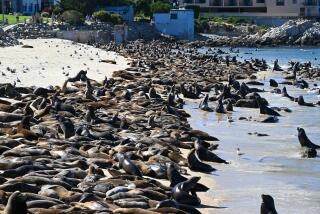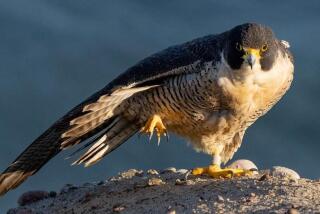Bay Area Group Keeps a Sharp Eye on Raptors
SAUSALITO — A red-tailed hawk flutters its wings and rises on the breeze from a hillside on the Marin Headlands, carrying the dreams of a special group of birdwatchers as he soars majestically over San Francisco Bay.
The young raptor is just one of about 20,000 hawks, eagles and falcons that migrate each fall along the Pacific Coast on a path that converges over the rugged hills just north of the Golden Gate Bridge.
What triggers bird migration and the mechanisms that keep the feathered travelers on the right path still is uncertain, said ornithologist Allen Fish, but these birds of prey could help solve the mysteries of migration and play a role in saving endangered species.
Riding the Currents
A natural funneling effect apparently causes the birds to converge in the area on their southern migration, Fish said. The water-shy creatures soar over the hills seeking updrafts to boost them into the sky before they soar over the mile-wide watery gap between Marin County and San Francisco, he said.
“If we had similar knowledge about the California condor 10 years ago, there would be a lot more California condors today,” Fish said.
The Golden Gate Raptor Migration Observatory he directs is tracking raptors on seasonal shifts that extend from Vancouver, Canada, to Argentina.
“We’re in a great position to study things about these birds that have never been studied before,” he said.
Project goals include raptor protection and increasing public awareness of the importance of saving wildlife habitats, Fish said. “Until wildlife problems are seen as habitat problems, we’ll always be two steps behind, we’ll always be fighting.”
The Marin site is one of the top three hawk-watching spots in the country, according to Fish. Only Pennsylvania and New Jersey have better spots.
“This is really an incredible focal point for bird recovery along the Pacific Coast,” Fish said of the area that’s in the Golden Gate National Recreation Area. “We have no concerns about anyone building a condominium here on top of a bird migration site. That’s a great peace of mind.”
So far, the group has tagged about 750 birds with numbered metal bands from the U.S. Fish and Wildlife Service to help keep track of raptors that turn up in other areas.
Banding by trained volunteers is open to spectators on Saturdays through October. The birds are snared in traps set at undisclosed sites, then are weighed, measured, closely examined and banded before they’re set free.
Sponsor a Bird
Raptors can also be “sponsored.” For a fee of $25 for a red-tailed hawk to $100 for an American kestrel, sponsors are kept abreast of data collected on “their” individual bird.
Fish hopes that the study will continue for the next 20 years or more, saying it’s crucial to cover at least the five-to-seven-year life span of the red-tailed hawk in order to help answer migration and other questions.
More to Read
Sign up for Essential California
The most important California stories and recommendations in your inbox every morning.
You may occasionally receive promotional content from the Los Angeles Times.










